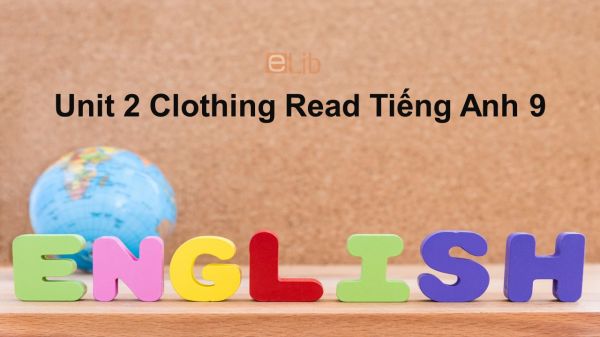Unit 2 lớp 9: Clothing-Read
Bài học Unit 2 lớp 9 "Clothing" phần Read hướng dẫn các em kỹ năng đọc hiểu với nội dung bài học liên quan đến lịch sử ra đời của quần jeans.
Mục lục nội dung

The word jeans comes from a kind of material that was made in Europe. The material, called jean, was named after sailors from Genoa in Italy, because they wore clothes made from it. In the 18th century jean cloth was made completely from cotton and workers at that time loved wearing it because the material was very strong and it did not wear out easily. In the 1960s, many university and college students wore jeans. Designers made different styles of jeans to match the 1960s’ fashions: embroidered jeans, painted jeans and so on. In the 1970s more and more people started wearing jeans because they became cheaper. In the 1980s jeans finally became high fashion clothing, when famous designers started making their own styles of jeans, with their own labels on them. Sales of jeans went up and up. But in the 1990s the worldwide economic situation got worse, and the sale of jeans stopped growing. However, jeans have never been out of fashion, and today- young generation is still fond of wearine them.
Dịch bài đọc:
Từ "quần jeans" phát xuất từ một loại chất liệu được sản xuất ở Châu Âu. Chất liệu gọi là jeans được đặt theo tên của những thủy thủ từ Genoa ở Ý vì họ mặc những trang phục làm từ đó. Vào thế kỷ 18, đồ jeans hoàn toàn được làm từ vải bông và vào thời điểm đó, công nhân thích mặc nó vì chất liệu đó dày và không dễ bị rách. Trong những năm 1960, nhiều sinh viên đại học và cao đẳng đã mặc đồ jeans. Các nhà thiết kế đã tạo ra nhiều mốt đồ jeans khác nhau cho phù hợp với thời trang những năm 1960: jeans thêu, jeans vẽ . . . Vào những năm 1970, ngày càng nhiều người mặc đồ jeans vì chúng đã trở nên rẻ hơn. Trong những năm 1980, jeans cuối cùng trở thành quần áo thời trang cao cấp, khi những nhà thiết kế nổi tiếng bắt đầu tạo nên phong cách riêng của mình cho đồ jeans, với nhãn hiệu của chính mình trên đó. Việc buôn bán đồ jeans ngày càng tăng vọt. Nhưng vào những năm 1990, tình hình kinh tế toàn cầu trở nên xấu đi, và việc buôn bán đồ jeans đã ngừng phát triển. Tuy nhiên jeans không bao giờ lỗi thời, và ngày nay thế hệ trẻ vẫn còn rất thích mặc chúng.
1. Task A Read Unit 2 lớp 9
Fill in the missing dates and words (Điền ngày và từ còn thiếu vào chỗ trống)
1.......... : Workers liked to wear ................. because the material made from cotton was very strong and could hardly wear out.
2.......... : A lot of university and college............ wore jeans.
3.......... : Jeans became........... so many, many people began wearing jeans.
4.......... : Jeans became high............ clothing.
5.......... : The.......... of jeans stopped going up.
Guide to answer
1. In the I8lh century: workers liked to wear jeans because the material made from cotton was very strong and hardly worn out.
2. In the 1960s: a lot of college and university students wore leans.
3. In the 1970s: jeans became cheaper, so many, many people began wearing jeans.
4. In the 1980s: jeans became high fashion clothing.
5. In the 1990s: the sale of jeans ended going up.
Tạm dịch:
1. Thế kỷ 18: công nhân thích mặc jeans vì chất liệu được làm từ vải sợ bông rất chắn chắn và khó mài mòn.
2. Trong những năm 1960: nhiều sinh viên đại học và cao đẳng mặc jeans.
3. Trong những năm 1970: jeans trở nên rẻ hơn vì vậy ngày càng nhiều người bắt đầu mặc jeans.
4. Trong những năm 1980: jeans trở thành trang phục thời thượng.
5. Trong những năm 1990: doanh số bán jeans ngừng tăng.
2. Task B Read Unit 2 lớp 9
Answer. Then write the answers in your exercise book (Trả lời. Sau đó viết câu trả lời vào vở bài tập)
1. Where does the word jeans come from?
2. What were the 1960s’ fashions?
3. Why did more and more people begin wearing jeans in the 1970s?
4. When did jeans at last become high fashion clothing?
5. Why did the sale of jeans stop growing?
Guide to answer
1. The word jeans comes from a kind of material that was made in Europe.
2. The 1960s' fashions were embroidered jeans and painted jeans.
3. In the 1970s, more and more people began wearing jeans because they became cheaper.
4. Jeans at last became high fashion clothing in the 1980s.
5. The sale of jeans stopped growing because the worldwide economic situation got worse in the 1990s.
Tạm dịch:
1. Từ jeans đến từ đâu?
Từ jeans đến từ một loại chất liệu được làm ở châu Âu.
2. Thời trang của những năm 1960 là gì?
Thời trang của những năm 1960 là jeans thêu và jeans in.
3. Tại sao trong những năm 1970 ngày càng nhiều người mặc jeans?
Trong những năm 1970 ngày càng nhiều người mặc jeans bởi vì chúng trở nên rẻ hơn
4. Cuối cùng jeans đã trở thành thời thượng khi nào?
Cuối cùng jeans đã trở thành thời thượng trong những năm 1980.
5. Tại sao doanh số bán jeans ngừng tăng?
Doanh số bán jeans ngừng tăng bởi vì tình hình kinh tế toàn cầu trở nên xấu đi trong những năm 1990.
3. Pratice
Read the following passage and choose the best answer.
We don't only choose clothes to make us look (1)______, we also use them to tell the world (2)______ our personality. The clothes we wear and our (3) ______ as a whole give other people useful information about what we think (4)______ we feel. If we feel cheerful, we usually wear (5) ______ clothes and if we feel (6) ______ we sometimes put on dark clothes. But why do teenagers wear black so(7)______? Is it because they feel miserable all (8)______? This is unlikely to be the case. It is probably just because it is (9)______ to wear black, and young people they are real fans of (10)______.
|
1. A. attract |
B. attractive |
C. attractively |
D. attraction |
|
2. A. of |
B. with |
C. by |
D. about |
|
3. A. appear |
B. appearance |
C. appeared |
D. appearing |
|
4. A. which |
B. what |
C. how |
D. when |
|
5. A. colorful |
B. colors |
C. colorfully |
D. colorless |
|
6. A. depress |
B. depressed |
C. depressing |
D. depression |
|
7. A. frequent |
B. frequency |
C. frequently |
D. frequents |
|
8. A. the time |
B. the day |
C. the week |
D. the month |
|
9. A. fashion |
B. fashionable |
C. fashioner |
D. fashioned |
|
10. A. fashion |
B. fashionable |
C. fashioner |
D. fashioned |
4. Conclusion
Qua bài học này các em phải ghi nhớ các từ vựng quan trọng như sau
- material (n): vật liệu
- embroidered: thêu
- sailors: thủy thủ
- fashions: thời trang
- fashionable (adj): hợp thời trang
- wear = put on: mặc
- label: nhãn hiệu
- economic (adj): thuộc về kinh tế
- economy (n): nền kinh tế
- economical (adj): tiết kiệm
- worldwide (adj): rộng khắp thế giới
- out of fashion: lỗi thời
